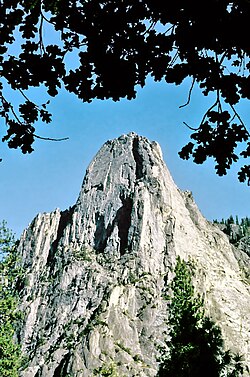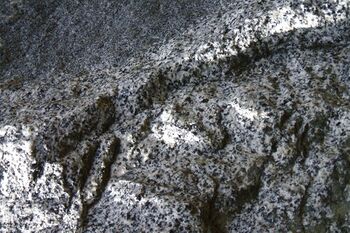Earth:Sentinel granodiorite
| Sentinel granodiorite Stratigraphic range: 93-85 Ma | |
|---|---|
 Sentinel Rock is made of Sentinel granodiorite | |
| Type | Geological formation |
| Unit of | Tuolumne Intrusive Suite |
| Location | |
| Location | California |
| Coordinates | [ ⚑ ] 37°43′43″N 119°35′45″W / 37.72861°N 119.59583°W |
| Country | United States |
| Type section | |
| Named for | Sentinel Rock |
Sentinel granodiorite is a type of granodiorite found in Yosemite National Park. It is a poorly understood western "outlier" of the ~93-85-Ma Tuolumne Intrusive Suite of the Sierra Nevada batholith. It is only slightly older than the undated Yosemite Creek Granodiorite and the Kuna Crest Granodiorite.[1]
Its name
Sentinel granodiorite was named after Sentinel Rock in Yosemite National Park, California .[2] The granodiorite forms part of the Tuolumne Intrusive Suite (Tuolumne Batholith), one of the four major intrusive suites within the Sierra Nevada.
An overview, its composition
Sentinel granodiorite has a less uniform composition than other Yosemite granites and granodiorites. On the west end of Yosemite Valley, it is more homogeneous and light-colored, and on the east, it is more streaky, with an uneven composition. On the east, it is also much darker than on the west.[3]
The chemical composition of Sentinel Granodiorite is less uniform than most of the other intrusive bodies. In the western part of the zone crossed by the Yosemite Valley Sentinel Granodiorite is homogeneous and lighter colored, though the eastern part it is more streaky with an uneven in composition; the texture and on the whole is considerably darker than the western part.[4]
Sentinel Granodiorite is a light-gray and medium-grained biotite-hornblende granodiorite. The color index is normally about 15, and ranges from 10 to 25. The hornblende is tabular, of crystals which are usually 4 - 6 millimeters long, and helps to define a weak to moderately strong magmatic foliation and lineation. Hornblende makes up from about 3% to 10% of Sentinel Granodiorite. Biotite makes up about 7% to 15%, and the crystals are one to five millimeters long. It is in an aggregate with the hornblende. Plagioclase makes up about 50% of Sentinel Granodiorite, and in size, ranges from one to ten millimeters. Interstitial potassium feldspar makes up ten to thirty percent of Sentinel Granodiorite, is two to five millimeters across. Sphene is abundant, but rarely more than 1% of Sentinel Granodiorite; it is wedge-shapes, and usually about 0.1 to 1 millimeter long, but can reach 2 millimeters in length. Other accessory minerals are allanite, zircon, and apatite.[5]
A soda-lime feldspar predominates over potash feldspar, and quartz is abundant. Hornblende and biotite are present in moderate, nearly equal amounts.[4]
Its relationship to Yosemite Creek Granodiorite
From Yosemite Creek Granodiorite, Sentinel Granodiorite varies only in texture: The plagioclase is white on its weathered surfaces, more euhedral, and the hornblende is smaller, less euhedral. There exists transitional Sentinel / Yosemite Creek Granodiorite.[5]
Where is it found

Sentinel Rock is composed entirely of Sentinel Granodiorite, gave it the name.[4][6]
Sentinel Fall pours over Sentinel Granodiorite.[7]
Its age
It is oldest unit in Tuolumne intrusive series. It has been assigned an age in the Late Cretaceous period, perhaps 90 Ma, perhaps as old as 94 Ma, or 96 to 94 Ma.[1][3][8]
Where found
The rock forms part of a large irregular intrusive body, but the portion of it here considered is a belt about 2 miles broad that crosses the valley from north to south.[4]
The walls of the Yosemite Valley consist mainly of a Sentinel granodiorite, a light-gray granitoid rock, from the Three Brothers to nearly as far east as the Royal Arches, and from the Fissures on the east, to Glacier Point.[4]
Rock climbing
In rock climbing, Sentinel Granodiorite is noted for its dihedrals,[9] plus for having dikes. Dikes of aplite and pegmatite commonly intrude on Sentinel Granodiorite. Dikes vary in width from less than one centimeter of over one meter, are usually ten to fifteen centimeters wide. They often extend several hundred meters, and have irregularly-shaped or web-like systems that can extend several tens of square meters.[5]
See also
- Bridalveil Granodiorite
- Cathedral Peak Granodiorite
- El Capitan Granite
- Geology of the Yosemite area
- Granite of Rancheria Mountain
- Half Dome Granodiorite
- Johnson Granite Porphyry
- Kuna Crest Granodiorite
- Mount Hoffman Granite
- Tuolumne Intrusive Suite
- Taft Granite
- Yosemite Creek Granodiorite
- Yosemite Valley Intrusive Suite
References
- ↑ 1.0 1.1 Structure of the Sentinel Granodiorite, Yosemite National Park, California – Books on Google Play: https://play.google.com/store/books/details/Joseph_M_Petsche_Structure_of_the_Sentinel_Granodi?id=OWfrbPb8hikC, accessdate: March 19, 2017
- ↑ USGS: Geological Survey Professional Paper 160 (The Granitic Rocks of the Yosemite Region): less uniform in composition than most of the other intrusive bodies. In the western part of the zone crossed by the Yosemite Valley this rock is relatively light-colored and homogeneous; the eastern part is much more streaky and uneven in composition and texture and on the whole is considerably darker than the western part. The eastern portion, again, may be roughly divided into two or three bands that differ mainly in texture., accessdate: March 19, 2017
- ↑ 3.0 3.1 George Wuerthner (1994). Yosemite, A Visitor's Companion. Stackpole Books. pp. 57–. ISBN 978-0-8117-2598-9. https://books.google.com/books?id=elVYAAAAMAAJ&dq=%22Sentinel+granodiorite%22+%22Sentinel+Rock%22&pg=PA125.
- ↑ 4.0 4.1 4.2 4.3 4.4 USGS: Geological Survey Professional Paper 160 (The Granitic Rocks of the Yosemite Region): USGS: Geological Survey Professional Paper 160 (The Granitic Rocks of the Yosemite Region), accessdate: March 18, 2017
- ↑ 5.0 5.1 5.2 "Structure of the Sentinel Granodiorite, Yosemite National Park, Califo" by Joseph M. Petsche: "Structure of the Sentinel Granodiorite, Yosemite National Park, Califo" by Joseph M. Petsche, accessdate: March 20, 2017
- ↑ George Wuerthner (1994). Yosemite: A Visitor's Companion. Stackpole Books. pp. 57–. ISBN 978-0-8117-2598-9. https://books.google.com/books?id=imwYphvLeRgC&dq=%22Sentinel+granodiorite%22+geology&pg=PA322.
- ↑ Geotripper: Under the Volcano: Changing the Emphasis -Part 3: Geotripper: Under the Volcano: Changing the Emphasis -Part 3, accessdate: March 18, 2017
- ↑ Sentinel publications: Geolex - Sentinel publications, accessdate: March 20, 2017
- ↑ Search The American Alpine Journal and Accidents: North America, United States, California - Yosemite, In Cold Blood, West Face of Sentinel Rock - AAC Publications - Search The American Alpine Journal and Accidents, accessdate: March 21, 2017
External links
- A Masters thesis
- A link, with a map
- Another map
- One link, speaks of various granodiorites
- Some images
 |

